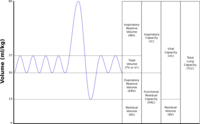
Photo from wikipedia
Abstract Objective: This study aims to evaluate the respiratory function of children and adolescents with osteogenesis imperfecta (OI) followed up at a referral center. Methods: A cross-sectional study was conducted… Click to show full abstract
Abstract Objective: This study aims to evaluate the respiratory function of children and adolescents with osteogenesis imperfecta (OI) followed up at a referral center. Methods: A cross-sectional study was conducted with a non-probabilistic sample. Manovacuometry was performed with the measurement of maximal inspiratory pressure (MIP) and maximal expiratory pressure (MEP), and in addition, peak expiratory flow (PEF) and ventilometry were performed to measure forced vital capacity (FVC). Results: In total, 23 individuals were evaluated, with a mean age of 11.6±3.4 years, 56.5% of whom were females. Regarding the classification of OI, 56.5% of the sample belonged to type IV, 30.5% to type III, and 13% to type I. The mean MIP was 64.4% of the predicted, and the mean MEP was 56.2% of the predicted. Overall, the mean PEF was 213.9 L/min, but only 140.6 L/min in the OI type III group. Median FVC was 1.9 L, corresponding to 110% of the predicted. Conclusions: Respiratory function of the study subjects was altered, with respiratory muscle strength values lower than expected in the whole sample, and peak expiratory flow was significantly reduced in the OI type III group.
Journal Title: Revista Paulista de Pediatria
Year Published: 2023
Link to full text (if available)
Share on Social Media: Sign Up to like & get
recommendations!